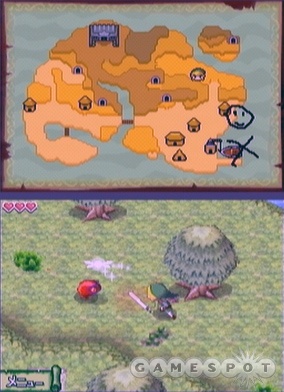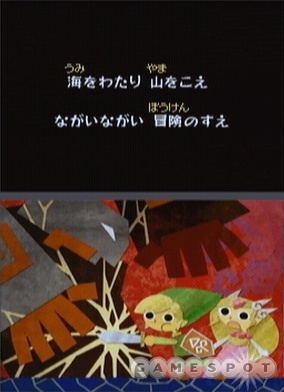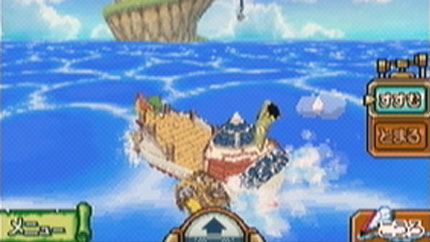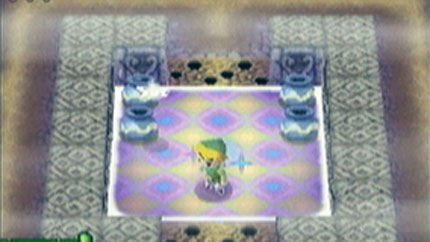Zelda: Phantom Hourglass Import Hands-On
Link and company have finally made their big splash on the DS in Japan with this stylus-driven follow-up to The Wind Waker.
It's hard to believe that the Nintendo DS will turn three years old later this year, and it's even harder to believe that it's taken this long for Nintendo to grace its latest handheld with an original Zelda game. But the waiting is over, at least in Nintendo's native land. The Legend of Zelda: Phantom Hourglass has finally hit the streets in Japan, and we eagerly scooped up an import copy to put it through its early paces and see how well the crazy, DS-specific changes to the Zelda formula have worked out. We've only put in a few hours with the game so far, but we've already gotten very used to the new touch-only control scheme and the lovely cartoonlike visuals. Without getting ahead of ourselves too much, we're suddenly very excited to see this one come out in English (as if we weren't excited for it already).
If you haven't been keeping up with Phantom Hourglass, one look at the game will tell you it's a direct successor to the first GameCube Zelda, The Wind Waker. The grittier, more mature style of Twilight Princess is nowhere to be seen; instead, cutesy, googly-eyed Link and Zelda are back for more whimsical action in a story that picks up directly after The Wind Waker. Following the defeat of Ganondorf, Link joined up with Zelda--sorry, Tetra--and her ragtag crew of pirates to ply the high seas in search of adventure and plunder. As the new game opens, the group's ship enters a mysterious area of the sea that's been responsible for more than its share of disappearances. A foreboding mist gathers, and a legendary, sinister-looking ghost ship emerges from the darkness. Fearless Tetra jumps right over the railing and onto the other ship to look for treasure, but the ghost ship's crew has other ideas. Link futilely tries to save her, but he tumbles overboard and washes away himself, leaving the fate of Tetra and the crew in doubt.

When Link washes up on the shore of a small island, he's awakened by a tiny fairy named Shiera, who looks and sounds an awful lot like Ocarina of Time's Navi. Shiera will act as your guide in a traditional sense, as she'll stop you and give you hints or directions from time to time. But she also acts as your cursor as you get used to Phantom Hourglass' intuitive touch-screen controls. Pretty much everything in the game is controlled by the stylus. You simply point in front of Link to tell him where you want him to run (similar to the movement in the DS version of Animal Crossing). The farther away from Link you touch the screen, the faster he'll run, and you can even do a little flick motion at the edge of the screen to have him break into a roll when he's running at full tilt.
The stylus controls extend to all of your combat activities too. A quick slash with the stylus will produce a similar result with your sword. You can also tap an enemy to have Link attack it directly; it's sort of like an immediate lock-on because you don't have to do any real aiming yourself. In fact, if you're far enough from your enemy, Link will even do a quick jumping downward slash that covers ground quickly and looks pretty cool to boot. A slash followed quickly by a circle movement will cause Link to do his trademark spin attack. You can even tap an object like a stone or a pot from across the screen, and Link will walk to it automatically and hoist it up. Then you can tap anywhere on the screen to have Link throw the item directly to that specific spot. It's all been extremely easy to figure out and use so far, and we'd dare to say we like these new controls better than the old D-pad-and-buttons combo. But further testing is required, of course.

During our time exploring the first island of the game, we've interacted with various townspeople and managed to finagle a basic sword from an old man who sympathized with Link and Tetra's plight. This involved exploring a cave and a very brief temple full of typical Zelda obstacles and pitfalls, such as bats, rodents, spiked floors, and trap doors. We haven't picked up any of the old Zelda mainstays, such as the compass, map, or big key, but we're pretty sure those will be featured in the game's proper dungeons later on. But we did enjoy some of the humor that's been mixed into the Zelda formula, such as when Link opened a big treasure chest, heard the triumphant four-tone theme that signifies a new item, and then held up...nothing at all, since the chest had already been emptied by a previous adventurer.
Because Phantom Hourglass takes place in the same world as The Wind Waker, you'll once again be traveling among a lot of relatively small islands. That means the sailing that admittedly met with mixed response from fans in the last game is back again, and we managed to gain our first ship within the first hour or so of the game so we could ride some waves ourselves. But luckily, this game will do a lot of the sailing for you. When you're ready to disembark from a port, you'll be shown a sea chart representing all the territory you've explored so far, and the map will be marked with other ports you can visit, as well as a few curiosities at sea, such as a floating item shop we encountered. To travel to any destination via boat, you only have to plot a course by drawing on the map with your stylus, and your ship will then follow that exact course with no more input required.

Once you're off and sailing, you can sit back and twiddle your thumbs if you like as Link travels to your next destination. You can make your ship hop up and down, as well as move the camera angle around in all directions, but otherwise it's steady as she goes. Luckily, you can stop your boat at any time to plot a new course from your current position, and we'd like to think you'll be able to kick back and do some fishing later on if you want. Speaking of aquatic life, we've seen some fish and other interesting creatures jumping out of the water as we've sailed around, so we figure that there will be certain areas of the sea you'll want to sail to for buried treasure and other points of interest, just like there were in The Wind Waker.
If you can't tell from the screenshots and movies, Phantom Hourglass does a masterful job of reprising The Wind Waker's characteristic visual style with the DS's relatively limited horsepower. Not only are the characters and overall tone consistent with the GameCube game, we've been duly impressed simply by the fidelity of the graphics on offer. This is really a great-looking game, by DS's standards. When you run up and talk to townspeople, the camera angle swings right down over your shoulder to show them up close, and while their polygon counts are limited, their expressiveness isn't. Based on the artistic prowess so far, we can't wait to see some of the more imaginative dungeon designs and two-screen boss encounters that are likely awaiting us deeper into the game. The little bit of the game we've seen so far has been very promising.

Phantom Hourglass may have labored in development for quite a while, but so far, the results speak for themselves. This one has the trademark Zelda polish all over it, from the superb visuals to the endearing characters and devious puzzle design (from what we've seen so far). But we're most excited about the new control scheme, which we admittedly went in expecting to dislike. Quite the contrary, we already can't imagine playing the game in the traditional fashion and can't wait to go through the whole adventure in English when Zelda: Phantom Hourglass hits shelves in North America in the fourth quarter of this year.
Got a news tip or want to contact us directly? Email news@gamespot.com
Join the conversation